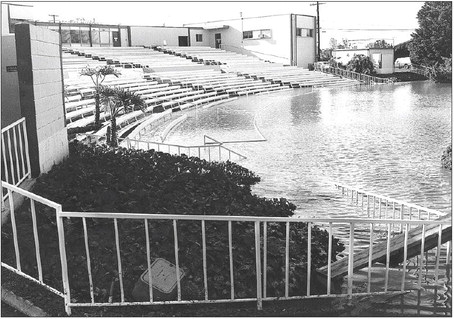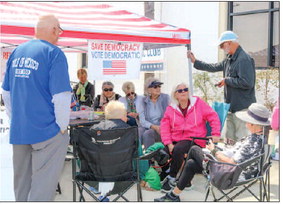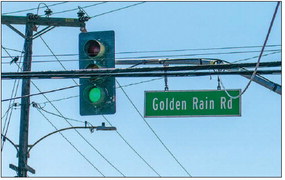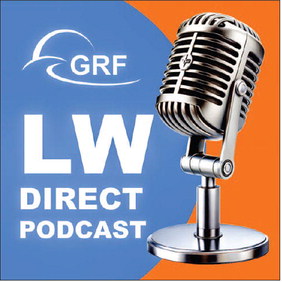LW was experiment in age-segregated lifestyle


PART 3
Leisure World’s innovative senior housing and services model provoked attention on how society would cope with its first generation of independent older citizens. In this last installment of Leisure World’s new Wikipedia entry, Mutual 5 GRF Director William Thompson documents critical events when Leisure World, because it was a pioneer, helped define the nation’s sociological and legal view of the aging process. Previous entries appeared in the Jan. 6 and Jan. 13 LW Weekly.
by William Thompson
GRF director
IN THE NEWS Should Elders Have Leisure?
Even before Leisure World Seal Beach was completed, the firm’s huge marketing campaign assured Leisure World would be the poster child in a national discussion of the social, economic and psychological implications of age-segregated communities. While some journalists lauded the youthful energy Leisure World residents exhibited, (30) one Newsweek writer suggested too much leisure weakened elderly minds. He mocked retirement villages as escapist, places where “reality and utopian fantasy merge in ‘an air of elegant euphoria.’” (50) Simultaneously, “old-age ghettos” was how a syndicated essay portrayed Leisure World and its ilk. (51) An Associated Press article, “Let’s Quit Working and Retire,” even chided the
pre-70-old retirees of Leisure World and similar developments for slacking in their duty to enrich the American economy (52).
1995 Flood
A flood control channel that traverses Leisure World Seal Beach overflowed in the wake of a 5-inch rainstorm on Jan. 4, 1995. Approximately 170 Leisure World units were declared uninhabitable, and 200 more suffered some water damage. The amphitheater’s bowl filled with 10 feet of water, while the basement of the Redeemer Lutheran Church held 12 feet of water. The Seal Beach mayor estimated the flood caused $2 million in damages. (53) Lawsuits
Leisure World Seal Beach’s pioneering role in introducing cooperative community governance to California led it to be a party in two important lawsuits that helped establish the state’s homeowners association (HOA) regulations:
• Golden Rain Foundation v. Leisure World Foundation (1965-1967): To assure creditors for the Seal Beach development would be paid, the Federal Housing Administration (FHA) advocated continued professional management of Leisure World. As community fees rose to pay for the Leisure World medical plan, an oftenbitter series of public meetings erupted pitting residents against management. (45) According to court documents, “a local city official” suggested to GRF’s executive director “that it might be well to conduct an investigation” of Lloyd Gummere, the leader of the residents’ protest group. When two private detectives were arrested for wiretapping Gummere’s phone, (54) an active revolt began. After a dissident slate of candidates unseated the 1963-64 GRF board, that incumbent board bound the 1964-65 board to a management agreement with a Cortese-affiliated company. (55) Some shareholders suggested the decision ceding control to Cortese’s now-multicommunity management company weakened the developers’ original promise that “residents will formulate the policies of the community” (56) Although facing vigorous opposition from the FHA, (57) the new GRF board sued Cortese. In October 1967, the court voided GRF’s agreement with Cortese’s national Leisure World Foundation, initiating the path to the present shareholder governance. (46)
• Golden Rain Foundation v. Carol Franz (2004-2008): A group of shareholders petitioned for access to GRF board documents under California regulations governing HOAs. GRF asserted that because GRF owned no residences, it was not an HOA, but a management company under contract to the home-owning mutuals. In a series of cases ending at the California Court of Appeals, GRF’s structure, which GRF’s expert witness testified was “unique” in the United States, was ruled to be an HOA and subject to all relevant provisions. (58) DEMOGRAPHICS
In 2019, 9,595 people, with an average age of 74, lived in Leisure World Seal Beach. Slightly more than 60 percent were female. Thirty-three percent of the community’s population was over 80. Fifty-one residents were aged 100 or more. (59) The population density of the development’s 535 acres is 11,477 people per square mile. (60) ATTRACTIONS
The Leisure World Globe, located at the development’s Seal Beach Boulevard entrance, is one of the nation’s largest globes. (61) Cortese wanted his new development to attract attention and remembered the 50-foot Globe-A-Drome in the 1939 Golden Gate International Exposition’s midway (62). Frustrated in his attempt to buy the original, he commissioned a 32-foot-tall, 14-ton rotating structure that originally was surrounded by fountains. (63) The Leisure World globe is frequently thought to be modeled on the 1964 New York World’s Fair Unisphere, (61) but it was completed months before the Unisphere’s plans were unveiled. (64) The Leisure World globe is the only free-standing sculptural piece listed among “Orange County’s 125 Icons” during the county’s 125th anniversary. (65) It was refurbished in 2016. (66) The Leisure World Amphitheater is a 2,500-seat outdoor performance space that hosts community gatherings and performances, as well as national entertainers. Its proscenium, stage and pit closely replicate the Hollywood Bowl’s first permanent structure, which opened in July 1922. (67) The Leisure World Historical Society Museum, a display of artifacts, photographs and documents, was located in the first-built Leisure World clubhouse. The development’s historical archives are now located at the University of California, Irvine.
A bronze statue of a ballerina, Premiere Danseuse Etoile, (68) by noted Italian sculptor Pino Conte (19151997), is mounted at the entrance to Leisure World Seal Beach’s Administration Building. Now referred to within the community as “Twiggy,” it was a 1963 gift to the community from the Corteses.
Located within a 3-mile radius of Leisure World are:
• California State University, Long Beach, including the Carolyn Campagna Kleefeld Contemporary Art Museum; Earl Burns Miller Japanese Garden; Carpenter Arts Center (the Carpenters’ memorabilia are exhibited in this concert hall); and the Walter Pyramid, an 18-story CSULB arena that is one of the United States’ three true pyramids.
• Joint Forces Training Base—Los Alamitos, including the JFTB Aquatics Center (the U.S. Women’s National Water Polo Team training site is open to public) and the Navy Golf Course, a public 27-hole facility that was Tiger Woods’ childhood home course.
• Long Beach Marina, the U.S.’s largest municipally owned marina system, with 3,600 slips. (69)
• Naples Island
• Old Town Seal Beach, featuring the Seal Beach Municipal Pier—at 1,835 feet, California’s second-longest wooden pier. (70)
• San Gabriel River Trail, a 35-mile trail from Azusa to Seal Beach that passes alongside the community.
• Seal Beach National Wildlife Refuge
• U.S. Naval Weapons Station Seal Beach, which is the site of the World War II National Submarine Memorial-West.
IN POPULAR CULTURE
In 1964, ABC’s “Queen for a Day” broadcast an entire show dedicated to women in Leisure World. At the show’s conclusion, host Jack Bailey granted that day’s winner, Leisure World resident Mabel Menke, with her wish for a new tricycle. (71) In 1986, a segment of NBC’s “Highway to Heaven,” starring and directed by Michael Landon, was filmed at Leisure World Seal Beach. NBC premiered the episode, titled “Love

Director Michael Landon used Leisure World as a location for a 1986 “Highway to Heaven” episode.

The Veterans Memorial was a helicopter landing pad in the 1980s. Note the library building outside the wall.

Kate Pedigo, who lived to be 105, was a noted folk-art painterand writer. The LW Library's collection holds her works.



